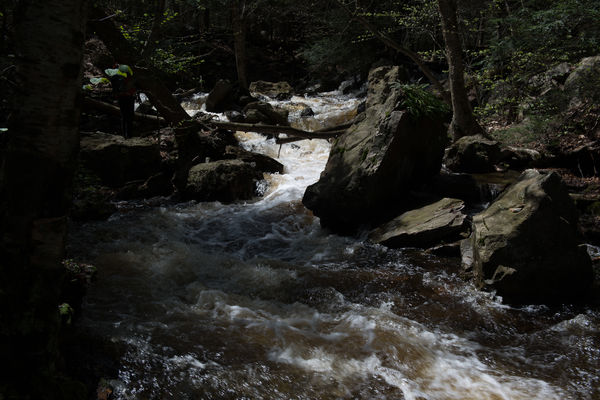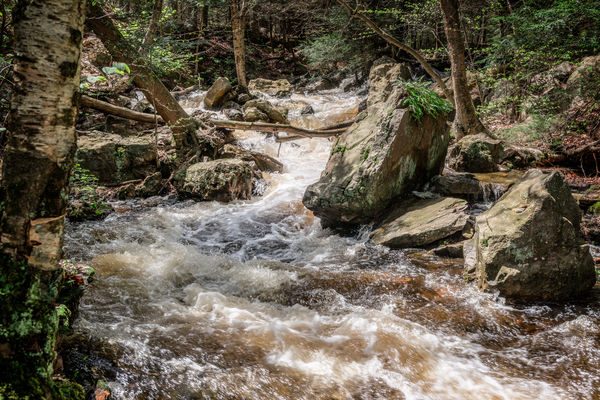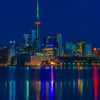Bracketing/Why?
Sep 24, 2017 06:23:12 #
kfoo wrote:
I have read some articles on bracketing. They say that when you bracket photos, you underexpose 1 frame and overexpose 1 frame and 1 just right. If you can go to post processing programs and change everything, what good does it do to bracket if you can change every in pos processing? Am I missing something in these articles? I am just starting in photography and am still learning. Thanks in advance.
And this is an example of what can be done with a more recent camera with current software and exposing to protect the highlights - done without bracketing. I used a D800 and a newer version of Lightroom. I exposed for proper detail in the sunlit water in the center of the image. I used exposure, highlight and shadow recovery to re-balance the tones, then a trip through Photoshop to remove the woman in the red jacket and do some local contrast sharpening and noise abatement. The newer cameras are great. But much depends on exploiting the capabilities of both software and camera - I only shoot raw for this reason. This would not have been possible within the limitations imposed when you try and work with jpegs produced by the camera.
Sep 24, 2017 06:31:29 #
TheDman
Loc: USA
rmalarz wrote:
Then again, if you expose correctly and know the limits of your camera, a single exposure accomplishes the same thing.
--Bob
--Bob
Your failed to accomplish it, since what's outside the door is blown out.
Sep 24, 2017 07:06:54 #
kfoo wrote:
I have read some articles on bracketing. They say that when you bracket photos, you underexpose 1 frame and overexpose 1 frame and 1 just right. If you can go to post processing programs and change everything, what good does it do to bracket if you can change every in pos processing? Am I missing something in these articles? I am just starting in photography and am still learning. Thanks in advance.
When shooting RAW, if you have an error in White Balance, you can fix it in post no matter how far off it is. Exposure is a different story. If your exposure is far enough off to lose detail, you can't get it back. Too much exposure correction when shooting RAW can affect your image quality. Especially when you are starting out learning how to achieve the best exposure, bracketing can be useful so you can compare which one is best. As you learn how to expose correctly, there is less need for bracketing, unless you need to use HDR to capture a very contrasty scene.
Sep 24, 2017 07:43:18 #
If you can take a perfectly exposed photo every time you do not have to bracket. If the photo you take is important and can not be taken over again, then bracket. Taking a photo that is over or under exposed and then correcting the exposure in Light Room or Photoshop is not the right way. It can be done, wastes time, and does not make you a good photographer.
Sep 24, 2017 07:47:31 #
kfoo wrote:
I have read some articles on bracketing. They say that when you bracket photos, you underexpose 1 frame and overexpose 1 frame and 1 just right. If you can go to post processing programs and change everything, what good does it do to bracket if you can change every in pos processing? Am I missing something in these articles? I am just starting in photography and am still learning. Thanks in advance.
You bracket when there is more variation (dynamic range) in the physical scene than you camera can capture in one image. For example, detail in the shadows and detail in the bright areas. 3 or more exposures allow you to properly expose each distinct area of the frame and then composite them into a final image that preserves the detail of each. The reason for this difficulty in understanding is that the human eye/brain can process the scene and all of the details much better than film/digital sensors can. You have to capture RAW files to maximize the effort.
Sep 24, 2017 08:16:52 #
petego4it
Loc: NY
Historically, I've bracketed a lot. Why? Initially as a film photographer because I found underexposing would notably help increase color saturation and that I often, in fact almost half the time preferred a half to a full stop of scene underexposure as the best shot. More recently with digital's wider dynamic range, and the related ETR logic, that's not so much a factor. Still useful tho because I still find that camera adjusted exposures can be preferable to those "fixed" in time consuming post...and thereby less post is needed and quicker output possible. Of course there are still the safety arguments of having more than one shot and now HDR... The arguments against are using up capacity on chip or disk, and needing to expend notable time sorting and throwing out the many more shots one downloads. Net, net for me still a valuable option.
Sep 24, 2017 08:48:09 #
Beautiful example. Thank you.
Gene51 wrote:
It's really very simple, and it is a technique I u... (show quote)
Sep 24, 2017 08:52:14 #
A great discussion on the pros and cons of bracketing. But then there a some of us who favor SOOC (straight out of camera)in order to minimize the time spent in PP. Without denigrating the importance of good post processing, I have found that bracketing to compensate for lighting irregularities gives me a variety of images to choose from which often spares me post processing time.
Sep 24, 2017 09:08:38 #
Bracketing serves two purposes, the first one is to prepare three files (sometimes more) for HDR photography and the other is to make sure that one of the exposures will be correct for the subject. Today most photographers opt for the first option.
Sep 24, 2017 09:27:59 #
gvarner
Loc: Central Oregon Coast
Bracketing is just another tool. Like all tools in photography, it has its place. The first thing you have to do is to decide how much contrast you can accept in your composition, or with HDR, what you want the final contrast to be.
Sep 24, 2017 09:49:07 #
tradio wrote:
There is a lot of lost information in the areas that are over-exposed and under exposed. So by using the details in the shadows and highlights, you can blend them together to create an image with high dynamic range or an HDR image.




Sep 24, 2017 09:54:10 #
AZNikon
Loc: Mesa, AZ
rgrenaderphoto wrote:
Position yourself inside your house/apartment/whatever where you have a window that faces outside, where the sun has brightly lit the yard. Focus on the window and take a photo. What do you have, a view outside but the interior of the room is dark? Now, take another exposure but use bracketing with + 1 stop. Merge them together in an application that supports HDR. You will see the room and the exterior view exposed correctly.
Thats what bracketing is for.
Thats what bracketing is for.
Well put!

Sep 24, 2017 10:19:59 #
kfoo wrote:
I have read some articles on bracketing. They say that when you bracket photos, you underexpose 1 frame and overexpose 1 frame and 1 just right. If you can go to post processing programs and change everything, what good does it do to bracket if you can change every in pos processing? Am I missing something in these articles? I am just starting in photography and am still learning. Thanks in advance.
Bracketing is a good idea especially when still learning. It provides different exposures from which you can choose the one with the best dynamic range for further editing. It provides different exposures from which you can choose for HDR. It provides insurance for when you misjudge the exposure that will get the best results. Sometimes it is a photo you will not be able to take again, and it becomes important to have a version that works, rather than is less than what you wanted to capture.
Bracketing can be as simple or as complex as you choose. The 3-frame bracket is standard, but for a scene with an extremely wide dynamic range, it is often better to take additional frames over and under. This is done manually by moving the exposure dial a couple of clicks above and below the "correct" exposure for additional brighter and darker versions. Of course, as Gene51 pointed out, if you have one of the newer cameras that have a greater capacity to handle dynamic range, you will be fine with the standard 3 frames.
Another use of bracketed photos is to make a composite image, rather than HDR. Done in Photoshop, using layers, this can work fairly well for scenes where there has been some slight movement and the images do not exactly overlap. I have also used it for macro shots where the bracketing is done manually for focus. For instance, a flower where the shallow depth of field causes the petals focused on to be in focus, the others out of focus. Multiple shots with focus on different petals and/or stamens and pistils can then be combined.
Note: When combining images, for the most accurate results, a tripod is required.
Hope this helps!
Susan
Purple Dragon ground cover 1/4" flowers
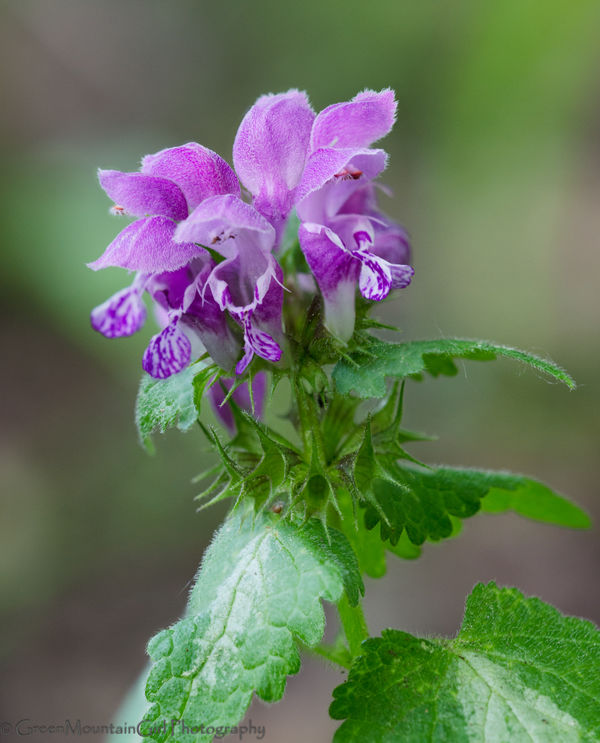
Lilys
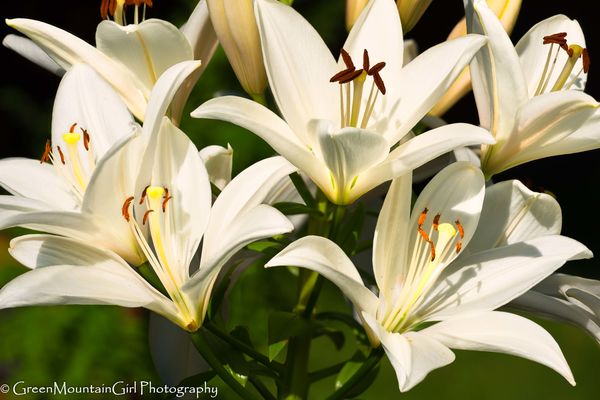
Sep 24, 2017 12:13:53 #
Retired fat guy with a camera wrote:
I absolutely hate bracketing. I hate the time it takes to delete all the repetitive files. You can fix the exposure in post production. It is turned off on both my cameras.
Or you can spend some money, and buy a digital light meter. I bought a used Sekonic 308 s, on ebay for a 100 dollars. Less files and it is deadly accurate.
Or you can spend some money, and buy a digital light meter. I bought a used Sekonic 308 s, on ebay for a 100 dollars. Less files and it is deadly accurate.
Simply not true. You cannot increase or decrease the RANGE of exposure in any post processing programs to pick up the extended range of the bracketed photo on both sides of the "right on" exposure. Not even shooting only RAW.
A meter helps, but only on getting a shot at one exposure, perhaps above and below the "best exposure by the camera".
You are trying to use the meter to still only use one shot. Yes, bracketing is a PITA, but depending on your demand for the best picture possible, or best image for your client.
We used bracketing a lot when shooting film, and learned the real value of it. Digital and post processing did not replace fully the use of bracketing for best image range. Most who shot film and bracketed, have not found digital to preclude the benefits of bracketing. One can always improve the image with bracketing, when one knows what he/she is doing. Others don't understand the benefits or are purely lazy and fear organization.
On that note I no longer need top/highest quality for my images being out of the business. My images satisfy me, so I hardly do any bracketing. But anyone who thinks bracketing is a useless process is simply wrong. And a Seconic 308s is not a refined enough meter to replace bracketing. Neither is a Sekonic 758 with all the bells and whistles.
Sep 24, 2017 12:31:41 #
There are at least three things in life for people who either don't know what they want or can't make a decision.
Medium Coke
The color beige
bracketing.
Just kidding folks.


Medium Coke
The color beige
bracketing.
Just kidding folks.



If you want to reply, then register here. Registration is free and your account is created instantly, so you can post right away.

